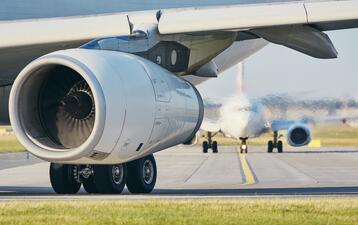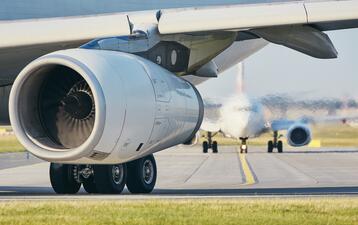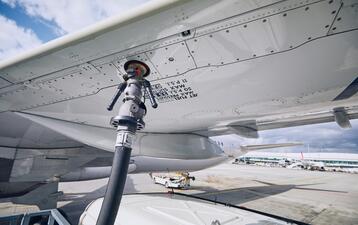Aviation Sustainability & Environmental Impact of Airports
Airports today are of critical economic and societal importance; arguably, the emissions generated by aircraft have a major impact on the surrounding environment and, in the case of aircraft noise, are often a source of conflict between airspace users, airport operators, regulators and policy makers, and communities and their citizens. In particular, aircraft noise pollution around airports is often the most important limiting factor for airport development.
Specifically in the vicinity of airports, aircraft emissions and their environmental impacts are a complex technical issue with many interactions that are often misunderstood by the stakeholders and affected parties involved.
The objective of this three-day course is to provide a high-level understanding of aircraft noise, engine emissions and related environmental protection measures. To this end, topics will be covered such as: Aircraft emission sources, legal framework in international, European context, aircraft noise and air pollutant certification, environmental impacts of aircraft operations, health effects and implications, monitoring and control systems, modeling and simulation techniques (ECAC Doc 29, BADA, ANP), environmental assessment methods, and active and passive mitigation strategies.
Practical examples and exercises will be used to present the latest developments and scientific studies as well as available software tools for monitoring or forecasting airport emissions (e.g. FAA Aviation Environmental Design Tool – AEDT).
This course is intended for an international audience of aviation professionals (including airport operators, airlines, air navigation service providers), as well as representatives of planning authorities and other environmental authorities. Stakeholders involved in other aspects of the environmental impact of aviation around airports (e.g., lawyers or land use planners) are also addressed in this course.
Please note: This course can be booked as an In-house version in German or English - however, the course material is only available in English. The German course version covers German specific topics related to aircraft noise and engine emissions, such as German specific aircraft noise calculation methods („AzB“) and legislation.
Course Details
Location:SingaporeLanguage:English
Date:25.06. - 27.06.2024
Duration:3 days
Provider:airsight Singapore Pte. Ltd.
Course Fee
No taxes will be added to the invoice for courses in Singapore.
Please note: This course is run by airsight Singapore Pte. Ltd. Terms & Conditions of airsight Singapore Pte. Ltd. apply.
Course Content
Fundamentals and emission sources of airplanes, helicopter and drones
- Noise vs. engine emissions
- Physical basics of technical acoustics
- Noise/Emission reduction technologies
- Emerging technologies (SAF, hydrogen/electric aircraft)
Regulatory framework
- International regulations (ICAO Annex 16, ICAO manuals related to environmental protection)
- European regulations and directives
- European initiatives on sustainability (Clean Sky, Flight Path 2050, SESAR)
- Market-based measures: CORSIA, EU-ETS/EUAA
- Airport Carbon Accreditation
Aircraft noise and engine emissions certification
- ICAO Annex 16
- EASA CS-36 Aircraft Noise
Noise and health (Impact of noise on humans)
- Impact of noise/air pollutans on human health
- Assessment of community impacts
- Overview of scientific studies and guidelines related to noise impact on humans
Environmental impact of aircraft operation and mitigation measures
- Environmental / operational aspects
- Noise management systems
- Flight procedure design with respect to noise
- Air pollution around airports
- Noise-related landing charges and benchmarking systems
- Noise from aircraft on the ground / engine run up
- Passive Noise Protection / Noise abatement measures
- Other environmental impacts and mitigation measures
Noise and engine emissions modelling and monitoring
- Methods of noise modelling (segmentation, shortest distance approach,
- ECAC Doc 29 4th Edition – Airport Noise modeling
- Other aircraft noise calculation techniques (German AzB, sonAIR, FLULA)
- Noise contour mapping using GIS
- Aerodrome noise and track monitoring system
- Emission modeling (BADA, BFFM2, FOA)
- Examples & Live-Demo (Demonstration of Aviation Environmental Design Tool, AEDT)
Environmental impact assessment
- Environmental problems arising from construction/expansion of airports and associated infrastructure
- Assessment methods for aircraft noise and engine emissions
- Environmental management activities and systems (ISO 14000 and EMS)
Trainer
Christoph Strümpfel, M.Sc.
Christoph is an expert for sustainable aviation within airsight’s consulting division. He is responsible for all training courses related to sustainable aviation and environmental protection around airports, sharing his knowledge and practical experience with other national and international aviation experts.
After graduating as Master of Science in Aeronautics and Astronautics from the Technical University of Berlin, he worked as a research assistant and lecturer at the Chair of Flight Guidance and Air Traffic at the TU Berlin. In his scientific career, Christoph focused on modeling aircraft noise and emissions, UAS/eVTOL noise calculation and optimization of flight procedures with respect to environmental targets. For airsight he has conducted several environmental assessments and case studies such as Berlin, Leipzig, Luxembourg, Malta and Dubai.
As a member of the Aircraft Noise Commission at Berlin-Tegel Airport, Christoph was responsible for the conduction of field studies about continuous descent operations and noise abatement departure procedures with respect to aircraft noise modeling and monitoring. Since focusing on aircraft noise and emission modeling in his career, Christoph collected broad experience with the FAA’s Aviation Environmental Design Tool (AEDT).
Target Group
- Civil Aviation Authorities
- Transports and Environmental Authorities
- Airport Operators
- Air Navigation Service Providers
- Airlines
- Environment technical experts
- Municipalities and administrations
- Land-use planners
- Lawyers and legal professionals
Course Location
Participants are responsible for making their own travel arrangements. The accommodation and travel costs are at the charge of the participants. Please note that airsight does not perform any travel and hotel bookings for the participants.
The course fee includes the registration, training material and examination. Coffee breaks and business lunch are also included.
Organisational Details
The course hours are scheduled as follows:
09:00 am - 5:00 pm (SGT)
At the end of the course, all participants will receive an airsight certificate based on ICAO/EASA training regulations, which is highly recognized throughout the aviation industry.
About airsight Training
airsight Training course quality
airsight operates an ISO 9001 certified Quality Management System and pursues the objective to provide high quality services that fully meet the clients’ needs.
Course Details
Location:BerlinLanguage:English
Date:03.09. - 05.09.2024
Duration:3 days
Provider:airsight GmbH
Course Fee
For courses in Berlin:
All customers will be charged 19% VAT.
The final price will be shown on your invoice.
Please note: If you want to register several particpants from your company but need a single invoice for each, please register each of them seperately.
Course Content
Fundamentals and emission sources of airplanes, helicopter and drones
- Noise vs. engine emissions
- Physical basics of technical acoustics
- Noise/Emission reduction technologies
- Emerging technologies (SAF, hydrogen/electric aircraft)
Regulatory framework
- International regulations (ICAO Annex 16, ICAO manuals related to environmental protection)
- European regulations and directives
- European initiatives on sustainability (Clean Sky, Flight Path 2050, SESAR)
- Market-based measures: CORSIA, EU-ETS/EUAA
- Airport Carbon Accreditation
Aircraft noise and engine emissions certification
- ICAO Annex 16
- EASA CS-36 Aircraft Noise
Noise and health (Impact of noise on humans)
- Impact of noise/air pollutans on human health
- Assessment of community impacts
- Overview of scientific studies and guidelines related to noise impact on humans
Environmental impact of aircraft operation and mitigation measures
- Environmental / operational aspects
- Noise management systems
- Flight procedure design with respect to noise
- Air pollution around airports
- Noise-related landing charges and benchmarking systems
- Noise from aircraft on the ground / engine run up
- Passive Noise Protection / Noise abatement measures
- Other environmental impacts and mitigation measures
Noise and engine emissions modelling and monitoring
- Methods of noise modelling (segmentation, shortest distance approach,
- ECAC Doc 29 4th Edition – Airport Noise modeling
- Other aircraft noise calculation techniques (German AzB, sonAIR, FLULA)
- Noise contour mapping using GIS
- Aerodrome noise and track monitoring system
- Emission modeling (BADA, BFFM2, FOA)
- Examples & Live-Demo (Demonstration of Aviation Environmental Design Tool, AEDT)
Environmental impact assessment
- Environmental problems arising from construction/expansion of airports and associated infrastructure
- Assessment methods for aircraft noise and engine emissions
- Environmental management activities and systems (ISO 14000 and EMS)
Trainer
Christoph Strümpfel, M.Sc.
Christoph is an expert for sustainable aviation within airsight’s consulting division. He is responsible for all training courses related to sustainable aviation and environmental protection around airports, sharing his knowledge and practical experience with other national and international aviation experts.
After graduating as Master of Science in Aeronautics and Astronautics from the Technical University of Berlin, he worked as a research assistant and lecturer at the Chair of Flight Guidance and Air Traffic at the TU Berlin. In his scientific career, Christoph focused on modeling aircraft noise and emissions, UAS/eVTOL noise calculation and optimization of flight procedures with respect to environmental targets. For airsight he has conducted several environmental assessments and case studies such as Berlin, Leipzig, Luxembourg, Malta and Dubai.
As a member of the Aircraft Noise Commission at Berlin-Tegel Airport, Christoph was responsible for the conduction of field studies about continuous descent operations and noise abatement departure procedures with respect to aircraft noise modeling and monitoring. Since focusing on aircraft noise and emission modeling in his career, Christoph collected broad experience with the FAA’s Aviation Environmental Design Tool (AEDT).
Target Group
- Civil Aviation Authorities
- Transports and Environmental Authorities
- Airport Operators
- Air Navigation Service Providers
- Airlines
- Environment technical experts
- Municipalities and administrations
- Land-use planners
- Lawyers and legal professionals
Course Location
Participants are responsible for making their own travel arrangements. The accommodation and travel costs are at the charge of the participants. Please note that airsight does not perform any travel and hotel bookings for the participants. Rooms can however be booked directly by the participants by contacting the hotel.
The course fee includes the registration, training material and examination. For non-virtual courses, coffee breaks and business lunch are also included.
Organisational Details
The course hours are scheduled as follows:
first training day: 10:00 am - 5:00 pm
mid-training days: 9:00 am - 5:00 pm
last training day: 8:00 am - 4:00 pm
Coffee breaks and business lunch are included in the course fee. At the end of the course, all participants will receive an airsight certificate based on EASA training regulations, which is highly recognized throughout the aviation industry.
About airsight Training
airsight Training course quality
airsight operates an ISO 9001 certified Quality Management System and pursues the objective to provide high quality services that fully meet the clients’ needs.
Course Details
Location:BerlinLanguage:German
Date:18.11. - 21.11.2024
Duration:4 days
Provider:airsight GmbH
Course Fee
For courses in Berlin:
All customers will be charged 19% VAT.
The final price will be shown on your invoice.
Please note: If you want to register several particpants from your company but need a single invoice for each, please register each of them seperately.
Course Content
Fundamentals and emission sources of airplanes, helicopter and drones
- Noise vs. engine emissions
- Physical basics of technical acoustics
- Noise/Emission reduction technologies
- Emerging technologies (SAF, hydrogen/electric aircraft)
Regulatory framework
- International regulations (ICAO Annex 16, ICAO manuals related to environmental protection)
- European regulations and directives
- European initiatives on sustainability (Clean Sky, Flight Path 2050, SESAR)
- Market-based measures: CORSIA, EU-ETS/EUAA
- Airport Carbon Accreditation
Aircraft noise and engine emissions certification
- ICAO Annex 16
- EASA CS-36 Aircraft Noise
Noise and health (Impact of noise on humans)
- Impact of noise/air pollutans on human health
- Assessment of community impacts
- Overview of scientific studies and guidelines related to noise impact on humans
Environmental impact of aircraft operation and mitigation measures
- Environmental / operational aspects
- Noise management systems
- Flight procedure design with respect to noise
- Air pollution around airports
- Noise-related landing charges and benchmarking systems
- Noise from aircraft on the ground / engine run up
- Passive Noise Protection / Noise abatement measures
- Other environmental impacts and mitigation measures
Noise and engine emissions modelling and monitoring
- Methods of noise modelling (segmentation, shortest distance approach,
- ECAC Doc 29 4th Edition – Airport Noise modeling
- Other aircraft noise calculation techniques (German AzB, sonAIR, FLULA)
- Noise contour mapping using GIS
- Aerodrome noise and track monitoring system
- Emission modeling (BADA, BFFM2, FOA)
- Examples & Live-Demo (Demonstration of Aviation Environmental Design Tool, AEDT)
Environmental impact assessment
- Environmental problems arising from construction/expansion of airports and associated infrastructure
- Assessment methods for aircraft noise and engine emissions
- Environmental management activities and systems (ISO 14000 and EMS)
Trainer
Christoph Strümpfel, M.Sc.
Christoph is an expert for sustainable aviation within airsight’s consulting division. He is responsible for all training courses related to sustainable aviation and environmental protection around airports, sharing his knowledge and practical experience with other national and international aviation experts.
After graduating as Master of Science in Aeronautics and Astronautics from the Technical University of Berlin, he worked as a research assistant and lecturer at the Chair of Flight Guidance and Air Traffic at the TU Berlin. In his scientific career, Christoph focused on modeling aircraft noise and emissions, UAS/eVTOL noise calculation and optimization of flight procedures with respect to environmental targets. For airsight he has conducted several environmental assessments and case studies such as Berlin, Leipzig, Luxembourg, Malta and Dubai.
As a member of the Aircraft Noise Commission at Berlin-Tegel Airport, Christoph was responsible for the conduction of field studies about continuous descent operations and noise abatement departure procedures with respect to aircraft noise modeling and monitoring. Since focusing on aircraft noise and emission modeling in his career, Christoph collected broad experience with the FAA’s Aviation Environmental Design Tool (AEDT).
Target Group
- Civil Aviation Authorities
- Transports and Environmental Authorities
- Airport Operators
- Air Navigation Service Providers
- Airlines
- Environment technical experts
- Municipalities and administrations
- Land-use planners
- Lawyers and legal professionals
Course Location
Participants are responsible for making their own travel arrangements. The accommodation and travel costs are at the charge of the participants. Please note that airsight does not perform any travel and hotel bookings for the participants. Rooms can however be booked directly by the participants by contacting the hotel.
The course fee includes the registration, training material and examination. For non-virtual courses, coffee breaks and business lunch are also included.
Organisational Details
The course hours are scheduled as follows:
first training day: 10:00 am - 5:00 pm
mid-training days: 9:00 am - 5:00 pm
last training day: 8:00 am - 4:00 pm
Coffee breaks and business lunch are included in the course fee. At the end of the course, all participants will receive an airsight certificate based on EASA training regulations, which is highly recognized throughout the aviation industry.
About airsight Training
airsight Training course quality
airsight operates an ISO 9001 certified Quality Management System and pursues the objective to provide high quality services that fully meet the clients’ needs.
Course Details
Location:In-houseLanguage:German / English
Duration:4 days
Provider:airsight GmbH
Course Content
Fundamentals and emission sources of airplanes, helicopter and drones
- Noise vs. engine emissions
- Physical basics of technical acoustics
- Noise/Emission reduction technologies
- Emerging technologies (SAF, hydrogen/electric aircraft)
Regulatory framework
- International regulations (ICAO Annex 16, ICAO manuals related to environmental protection)
- European regulations and directives
- European initiatives on sustainability (Clean Sky, Flight Path 2050, SESAR)
- Market-based measures: CORSIA, EU-ETS/EUAA
- Airport Carbon Accreditation
Aircraft noise and engine emissions certification
- ICAO Annex 16
- EASA CS-36 Aircraft Noise
Noise and health (Impact of noise on humans)
- Impact of noise/air pollutans on human health
- Assessment of community impacts
- Overview of scientific studies and guidelines related to noise impact on humans
Environmental impact of aircraft operation and mitigation measures
- Environmental / operational aspects
- Noise management systems
- Flight procedure design with respect to noise
- Air pollution around airports
- Noise-related landing charges and benchmarking systems
- Noise from aircraft on the ground / engine run up
- Passive Noise Protection / Noise abatement measures
- Other environmental impacts and mitigation measures
Noise and engine emissions modelling and monitoring
- Methods of noise modelling (segmentation, shortest distance approach,
- ECAC Doc 29 4th Edition – Airport Noise modeling
- Other aircraft noise calculation techniques (German AzB, sonAIR, FLULA)
- Noise contour mapping using GIS
- Aerodrome noise and track monitoring system
- Emission modeling (BADA, BFFM2, FOA)
- Examples & Live-Demo (Demonstration of Aviation Environmental Design Tool, AEDT)
Environmental impact assessment
- Environmental problems arising from construction/expansion of airports and associated infrastructure
- Assessment methods for aircraft noise and engine emissions
- Environmental management activities and systems (ISO 14000 and EMS)
Trainer
Christoph Strümpfel, M.Sc.
Christoph is an expert for sustainable aviation within airsight’s consulting division. He is responsible for all training courses related to sustainable aviation and environmental protection around airports, sharing his knowledge and practical experience with other national and international aviation experts.
After graduating as Master of Science in Aeronautics and Astronautics from the Technical University of Berlin, he worked as a research assistant and lecturer at the Chair of Flight Guidance and Air Traffic at the TU Berlin. In his scientific career, Christoph focused on modeling aircraft noise and emissions, UAS/eVTOL noise calculation and optimization of flight procedures with respect to environmental targets. For airsight he has conducted several environmental assessments and case studies such as Berlin, Leipzig, Luxembourg, Malta and Dubai.
As a member of the Aircraft Noise Commission at Berlin-Tegel Airport, Christoph was responsible for the conduction of field studies about continuous descent operations and noise abatement departure procedures with respect to aircraft noise modeling and monitoring. Since focusing on aircraft noise and emission modeling in his career, Christoph collected broad experience with the FAA’s Aviation Environmental Design Tool (AEDT).
Target Group
- Civil Aviation Authorities
- Transports and Environmental Authorities
- Airport Operators
- Air Navigation Service Providers
- Airlines
- Environment technical experts
- Municipalities and administrations
- Land-use planners
- Lawyers and legal professionals
Organisational Details
airsight offers this training course on request, worldwide. At the end of the course, all participants will receive an airsight certificate based on EASA training regulations, which is highly recognized throughout the aviation industry.
About airsight Training
airsight Training course quality
airsight operates an ISO 9001 certified Quality Management System and pursues the objective to provide high quality services that fully meet the clients’ needs.

 Training 5 or more people? Ask for an In-house course at your premises or online!
Training 5 or more people? Ask for an In-house course at your premises or online!


